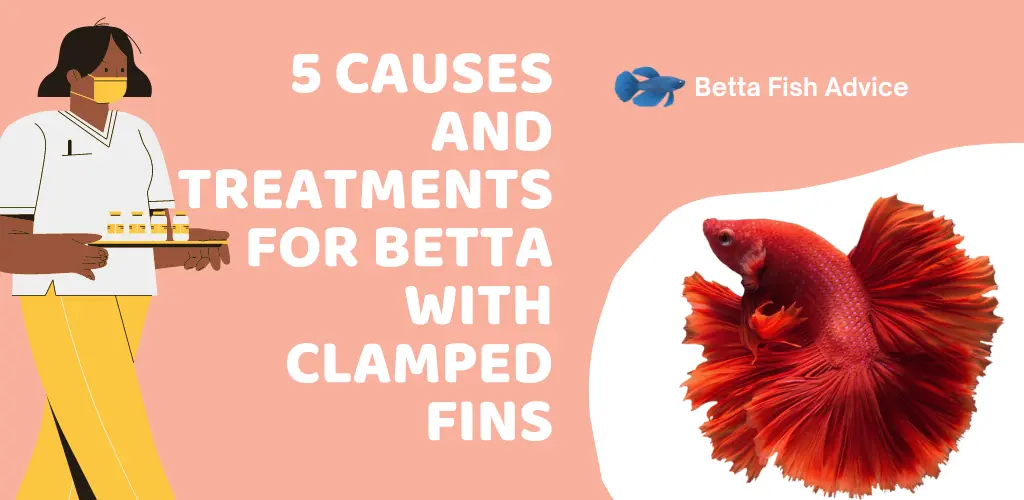Betta fish, also known as Siamese fighting fish, are popular among aquarium enthusiasts due to their vibrant colors and unique personalities. However, one issue that many betta fish owners may encounter is a condition known as “clamped fins.” Clamped fins occur when the fins of the fish appear to be pressed against the body rather than extending outwards as they typically would. Various factors can cause this condition, and betta fish owners must understand the causes and potential solutions to care for Betta with Clamped Fins.
Betta With Clamped Fins: Causes
There are several possible causes of betta with clamped fins, including:
- Water Quality: Poor water quality can lead to several health issues for betta fish, including clamped fins. High levels of ammonia, nitrite, or nitrate can all be harmful to fish and can cause fins to clamp against the body as a sign of stress. These pollutants can result from overfeeding, not performing regular water changes, or inadequate filtration systems.
- Temperature: Betta fish prefer water between 76 and 82 degrees Fahrenheit, and temperatures outside this range can cause stress and lead to clamped fins. Extreme temperatures, either too hot or too cold, can cause your fish to become stressed and uncomfortable, which can lead to clamped fins.
- Disease: Certain diseases, such as fin rot or bacterial infections, can cause the fins of a betta fish to clamp against the body. These diseases can be caused by various factors, such as poor water quality, overcrowding, or a weakened immune system due to stress.
- Parasites: Parasites, such as Ich or velvet, can also lead to clamped fins in betta fish. These parasites can cause itching and irritation, leading to the fish clamping its fins against its body to relieve the discomfort.
- Lack of Vitamin: Betta fish require a diet rich in vitamins and minerals to maintain healthy fins. A lack of these essential nutrients can lead to clamped fins. A diet lacking in vitamins and minerals can lead to poor fin health, including clamped fins.
One study published in the Journal of Aquatic Animal Health found that poor water quality was the most common cause of clamped fins in betta fish. The study also noted that betta fish kept in smaller tanks were more likely to develop clamped fins due to the increased buildup of waste and toxins.
Other factors contributing to clamped fins in betta fish include disease, temperature fluctuations, and stress from overcrowding or aggressive tank mates. Betta fish owners need to maintain high water quality and provide adequate space and enrichment for their fish to prevent clamped fins and other health issues.
Before and After Clamped Fins
Before a betta fish develops clamped fins, its fins will be extended outward and appear healthy and active. However, once clamped fins set in, the fins appear pressed against the body, and the fish may become less active or lazy. Clamped fins are a sign of stress, and if left untreated, they can lead to other health issues in the betta fish.
After treating the underlying cause of the clamped fins, such as poor water quality or disease, the fins will slowly start to extend outward again, and the fish will become more active and appear healthier. Addressing clamped fins as soon as possible is crucial to prevent further health issues in the betta fish.
Betta Clamped Fins Treatment

The first and most crucial step in treating betta with clamped fins is to identify the underlying cause. The cause could be due to various reasons, such as poor water quality, disease, or stress. By identifying the cause, you can take the necessary steps to address it and provide the appropriate treatment for your betta.
Ensuring Optimal Water Quality
One of the most important aspects of treating clamped fins in bettas is ensuring optimal water quality in their tank. This means that the water should be clean and free from harmful chemicals, toxins, and pollutants and that the water temperature should be appropriate for your fish. Bettas prefer water between 76 and 80 degrees Fahrenheit, and maintaining this temperature range is vital for their health. A clean and healthy environment will help improve the fins’ condition and the fish’s overall health.
Providing a Balanced and Nutritious Diet
Bettas are carnivorous and need a diet that is high in protein. Feeding them various food, such as brine shrimp, bloodworms, and daphnia can help improve their fins’ condition. A balanced and nutritious diet is crucial for your betta’s overall health and can help prevent future health issues.
Medication
In some cases, clamped fins may be caused by bacterial or fungal infections. In these cases, adding medication to the water can help fight these infections. Medications such as antibiotics and antifungals can be used to treat these types of infections and help improve the fins’ condition.
Monitoring and Seeking Professional Advice
It’s essential to keep an eye on your betta’s behavior and overall health. If the fins have not improved after a week or if the fish shows other signs of illness, it is crucial to seek advice from a veterinarian. With the right approach, you can help your betta recover from clamped fins and return to its happy and healthy self. A veterinarian can provide you with a more accurate diagnosis and recommend the best treatment for your betta.
Why Are Your Betta’s Fins Clamped After A Water Change
Several reasons a betta fish’s fins may clamp up after a water change. Bettas are tropical fish and prefer a specific range of water temperatures, pH levels, and hardness. A sudden change in any of these parameters can cause stress and result in fin clamping. One of the leading causes is a sudden change in water temperature. Bettas prefer water temperatures between 76-82 degrees Fahrenheit, and a sudden drop in temperature can cause them stress, leading to fin clamping.
Similarly, if the pH or water hardness levels have changed too much from the previous water, it can cause stress and fin clamping in bettas. Bettas prefer a pH level between 6.5-7.5 and a water hardness between 5-20 dGH, so if the new water has a significantly different pH or hardness level, it can cause stress and fin clamping. Additionally, bettas can be sensitive to chemicals such as chlorine and chloramines, often in tap water. These chemicals can cause stress and fin clamping if not adequately removed before use. It is vital to ensure that the new water is at the same temperature, pH, and hardness level as the previous water to minimize stress and prevent fin clamping.
Why Does Your New Betta Have Clamped Fins?
There are a few potential reasons why a new betta fish might have clamped fins. One possibility is that the fish is experiencing stress from being transported or acclimated to a new environment. Bettas are sensitive to changes in their environment and can become stressed when placed in a new tank or with new tankmates. This stress can cause their fins to clamp up as a defense mechanism. Another possibility is that the water conditions in the new tank are not suitable for the betta.
Bettas prefer a specific range of water temperature, pH, and water hardness; if these parameters are not met, they can cause stress and fin clamping. Additionally, the betta may suffer from an illness or disease, which can cause fin clamping. It is important to monitor the water conditions and ensure that they meet the betta’s needs and observe the fish for other signs of illness or disease, such as lethargy, lack of appetite, or abnormal behavior.
Why Is Your Betta Lethargic With Clamped Fins?

There are a few potential reasons why a betta fish might be lethargic with clamped fins. One possibility is that the fish is experiencing stress from poor water conditions or an unsuitable environment. Bettas are sensitive to changes in water temperature, pH, and water hardness; if these parameters are not met, they can cause stress and fin clamping. Additionally, the betta may be experiencing stress from other factors such as poor water quality, overcrowding, or aggressive tankmates.
Stress can cause the fish to become lethargic and clamp its fins. Another possibility is that the betta is suffering from an illness or disease. Certain infections or diseases can cause a fish to become lethargic and clamp its fins. It is essential to monitor the water conditions and ensure they meet the betta’s needs and observe the fish for other signs of illness or disease, such as lack of appetite, abnormal behavior, or discoloration of the fins and body. It is recommended to consult a veterinarian who specializes in fish health if you suspect an illness or disease.
Conclusion
Bettas with clamped fins are a common issue caused by various factors such as poor water quality, disease, or stress. To treat clamped fins, it is essential to identify the underlying cause, improve water quality, provide a balanced and nutritious diet, and provide medication when necessary.
Additionally, it is important to keep an eye on the betta’s behavior and overall health and seek professional advice if necessary. With the right approach, you can help your betta recover from clamped fins and return to its normal, healthy state. Remember, a healthy and clean environment, a balanced diet, and timely treatment will ensure your betta’s fins will be fit and your betta will be happy.
FAQ
Q: How can I prevent my betta fish from developing clamped fins?
You can avoid Clamped fins by keeping the water in your betta’s tank clean and well-maintained. You should also ensure your betta is not stressed and the water temperature is appropriate.
Q: Can a betta fish with clamped fins still eat and swim normally?
Yes, a betta fish with clamped fins can still eat and swim normally, although they may not be as active as they usually are.
Q: Is it normal for betta fish to have clamped fins occasionally, or is it a sign of a problem?
Clamped fins can occasionally occur in betta fish, but it is usually a sign of a problem such as poor water quality, disease, or stress.
Q: What other signs of illness in betta fish besides clamped fins?
Other signs of illness in betta fish include lethargy, loss of appetite, discoloration, bloating, and abnormal swimming patterns.
Q: Can clamped fins be caused by stress?
Yes, clamped fins can be caused by stress. You can reduce stress in your betta’s environment by providing them with a comfortable and appropriate living space, avoiding overcrowding, and maintaining good water quality.
Q: Can medication or water changes help improve a betta fish’s clamped fins?
Yes, medication and water changes can help improve a betta fish’s clamped fins. However, the underlying cause of the clamped fins needs to be addressed to prevent it from recurring.
Q: Can I try any home remedies to help my betta fish’s clamped fins?
Some home remedies you can try to help improve your betta fish’s clamped fins include:
- Adding aquarium salt to the water.
- Increasing the water temperature.
- Adding Indian almond leaves to the tank.
Q: Can a betta fish with clamped fins still breed, or will it affect their reproduction ability?
A betta fish with clamped fins can still breed, although it may affect its ability to swim and reach the female.




Pingback: Obese Betta Fish: Causes And Prevention - Betta Fish Advice
Pingback: How Long Can A Betta Fish Live Out Of Water? - Betta Fish Advice
Pingback: Why Is My Betta Fish Swimming Fast Back And Forth? - Betta Fish Advice
Pingback: How To Breed Black Samurai Betta: 4 Step Guide - Betta Fish Advice
Pingback: Betta Fish Temperature Shock: Prevention And Causes - Betta Fish Advice
Pingback: What Is Mustard Gas Betta: Ultimate Guide - Betta Fish Advice
Pingback: Can Betta Fish Have Seizures? Understanding The Causes And Symptoms